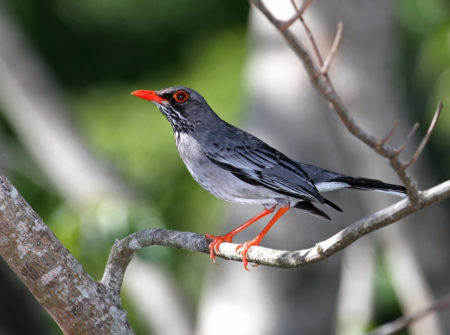
Spencer Schubert’s adventures into the remote corners of the Dominican Republic Part continue, all in the name of science and conservation.
If you are reading this, I probably do not have to convince you that birds are great. The more interesting discussion to be had, of course, would be what makes them so great. We are all drawn to birds for different reasons. For some of us, the sights and sounds they provide to the ambience of our backyard or local natural area are enough to endear them to us. For many others it comes from their experience as pet owners. Even the tradition of hunting can inspire reverence for birds and a passion for their conservation. I have always liked birds, but I can hardly claim that they were any more interesting to me than lizards or turtles, for example. Indeed, on my grumpiest of days, I sometimes refer to myself as a failed herpetologist.
My gateway to birds has been a fascination with their role as seed dispersers. It may not be the first thing that you notice, but no matter where you go, as long as you’re standing on dry land and there is some green vegetation nearby, you would be hard pressed to find somewhere where there aren’t birds eating fruits and seeds. These feeding behaviors by birds are a key component to many terrestrial ecosystems. By swallowing fruits or otherwise carrying away seeds in their bill, potentially flying great distances, birds give plants a major boost in their potential to propagate in the environment.
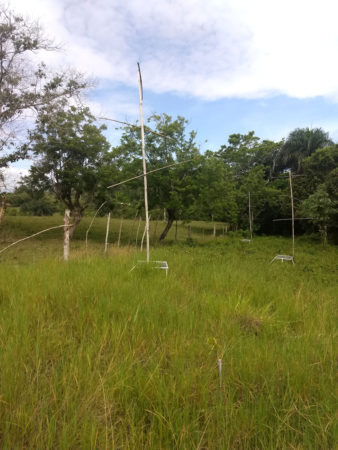
One of the major implications of seed dispersal in a world with ever diminishing forests is the prospects for degraded ecosystems to bounce back. About two years ago, I contributed an article to this blog on up-and-coming work in the small town Jarabacoa in the central mountains of the Dominican Republic. I was studying whether constructed perches could be used to attract birds to restoration sites on abandoned parcels of farmland, with the goal of promoting natural seed dispersal and forest recovery. It all began with a simple principle: If you build it, they will come.
To some extent this was true. We found that installing perches increased the number of birds visiting restoration plots. However, some key seed dispersers such as the Palmchat, Black-crowned Palm Tanager, and Red-legged Thrush – to name a few – showed little to no interest in our perches. So, I got to thinking, maybe we need a better sales pitch.
Have you ever walked down the streets of a popular street in town looking for a place to eat or hang out? Would you rather walk into an establishment that is silent with no sign of people inside or one that is bustling with music and laughter? Atmosphere is what you’re looking for. All else being equal, you’re much more likely to walk into a restaurant that sounds like there are a lot of people inside than one that is quiet and seemingly empty. We use these social cues to inform our judgments of the quality of different businesses all the time. As it turns out, birds are not so different.
Birders will already be familiar with the magic of playback. Many bird species are readily stimulated by hearing their own call and often rush in to investigate whether the sound is from a mate, new neighbor, or a potential intruder to the territory. This is often used to draw in shy birds for us to have a closer look at them or prompt them to reply for better identification (Note: Playback may cause unnecessary stress for some species, particularly during nesting season, and is prohibited in some parks and in many cases for threatened species). Similarly, birds may be drawn to the sounds of both their own kind and other species as a signal to flock up to find high quality habitat or food.
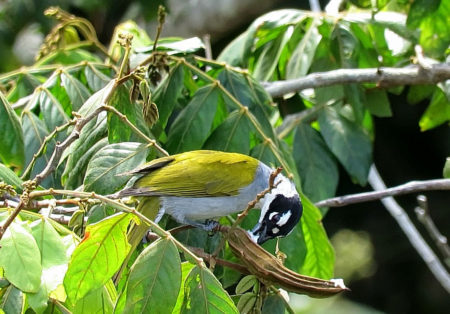
Here is where my idea set in. One aspect of my studies over the past four years has been the community-level analysis at our sites in the central Dominican Republic in an attempt to fully document all feeding/dispersal relationships between all of the bird and plant species that occur here. Through thousands of hours of observation, we have uncovered enormous variation in the extent to which different bird species act as seed dispersers.
Some “generalist” species are responsible for dispersing the seeds of large numbers of plant species. For example, our research has revealed that the Palmchat eats fruits from 42 species. That’s nearly half of all trees and shrubs that are found, collectively, at the sites we have surveyed! Other “specialist” species, like the Antillean Euphonia, are only known to feed on fruits from just a few species. So, if you were any average Joe Bird in the mood for some tasty fruits, which of these species would you rather take a recommendation from?
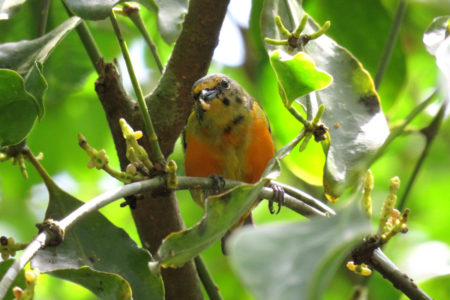
This is, effectively, the question we asked with our latest experiment. By broadcasting sounds of fruit-eating generalists, specialists, and birds that do not eat fruits in separate trials, we sought to test how these sounds affect bird activity in our restoration plots. We expected, first of all, that the sounds of particular species would attract members of that same species. Additionally, we expected experimental trials with sounds from generalist birds to attract more birds in general than in trials with sounds from specialists, non-frugivores, and no sound. We used digital video cameras to record the activity of birds in the plots during these experiments. At this time, we are still reviewing the footage from this study. But we have already seen some fascinating results! Several species that we had never before recorded in the plots were confirmed as visitors responding to the sound of their own species during this experiment.
Here we see a family of Grey Kingbirds (Tyrannus dominicensis) frolicking among the perches in one of our restoration plots. Kingbirds are, nominally, insectivores. However, they supplement their diet heavily with a large variety of fruits. Their propensity to venture out into open spaces to hunt for insects makes them highly prolific seed dispersers in deforested landscapes. (Video by Spencer Schubert)
Our work demonstrates that sound and social cues are likely a key factor in birds exploring degraded landscapes. And this exploration and habitat use by birds has a direct relationship with seed dispersal. While our work is only a first glance into these relatively unexplored aspects of bird behavior, there is reason to believe that it could have key implications for environmental management and conservation. Beyond simply tricking birds into showing up to a particular site, taking various measures to promote the local abundance of birds through providing resources and habitat can extend well beyond improving the well-being of birds. Helping birds in this context has great potential for restoring the ecosystem services like seed dispersal that birds provide, which will be key in our future struggle to support biodiverse and resilient ecosystems.
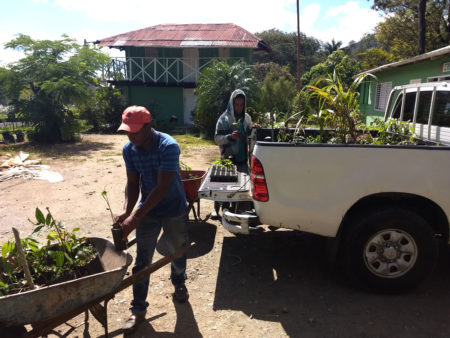
In the time since the inception of our project, we have taken steps to ensure that measures will be taken to improve management practices to make landscapes more supportive of bird populations. Our biggest push in this regard has been emphasizing the importance of planting native species both in restoration areas and in backyard landscaping projects to support native birds.
Over the past year, we have collected seed and grown seedlings of more than 30 species of native plants, all of which produce fruit resources for birds. In July of this year, we donated more than two hundred of these seedlings to Plan Yaque Inc. (a local NGO working to conserve natural resources in the Rio Yaqui del Norte watershed) and the Ministry of the Environment to incorporate into routine forest restoration projects, including the plots where we have done our experiments. We hope that this will be an important first step to reforming forest restoration practices so that they may become more sustainable and effective in promoting native biodiversity.
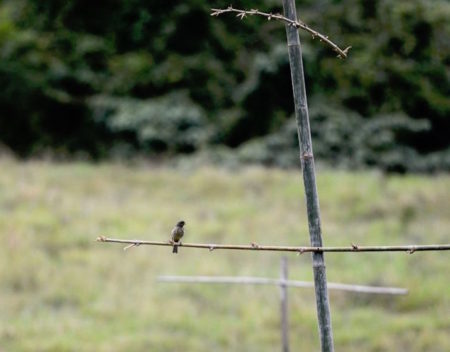
I owe gratitude to many individuals and organizations for their roles in supporting this project over the past several years. Chiefly among these were project technicians: Joaris Samuel Gonzalez and Juan Miguel Liberata. Field assistants: Alex Lascher-Posner, Paris Werner, Kim Shoback, Tyler Glaser, Alejandra Monsiváis, Juan Carlos Cárdenas, and Lara Grevstad. Dr. Eric Walters of Old Dominion University helped advise the project and has been instrumental in the progression of my ideas and my development as a scientist. Holly Garrod has closely partnered with this project as a collaborator during the course of MS thesis on todies of Hispaniola. Local organizations Plan Yaque and Rancho Baiguate have provided key logistic support, without which this work would not have been possible. Furthermore, numerous private land owners have generously received us on their farms to conduct our field studies. This research was funded jointly by the Rufford Foundation, the Sophie Danforth Conservation Award from Roger Williams Park Zoo, the Old Dominion University Kirk Wetland Research Award, and the David S. Lee Fund from BirdsCaribbean.
By Spencer Schubert. Spencer is Ph.D. student in the ecology program at Old Dominion whose thesis focuses on the contributions of avian seed dispersal to tropical forest recovery and plant-frugivore seed dispersal networks on farmland landscapes in the Dominican Republic. Spencer is a recipient of two BirdsCaribbean David S. Lee Fund Grants and is using his research as a platform to raise interest in the ecological importance of birds for restoration projects in the region around Jarabacoa.
